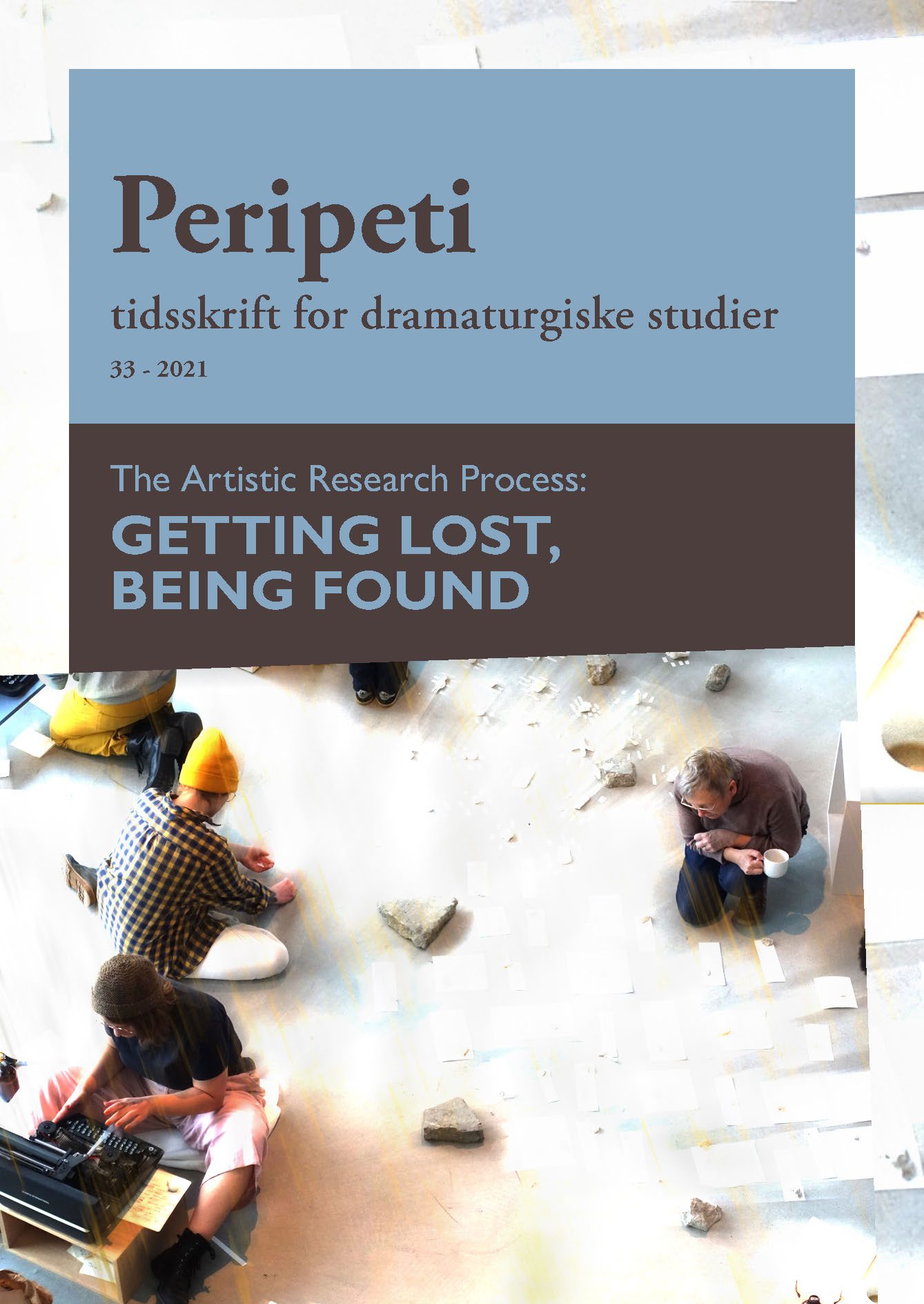The Carousel Concept as Assemblage Acting *
DOI:
https://doi.org/10.7146/peri.v18i33.124608Resumé
Since 2004 performer and acting teacher Marion Reuter has developed the carousel concept referring to an improvisation method for training multiple acting techniques and scenic functions. This article is based on my collaboration with Reuter and unfolds how my disincarnation theory of assembling different acting techniques enhances Reuter’s carousel practice and vice versa. The collaboration provided an opportunity to try out my theory in practice. The article and the collaboration are part of an artistic research project about the carousel concept at The Danish National School of Performing Arts (DDSKS) led by Marion Reuter. I acted as documentarist and dramaturge. The empirical backdrop for the article consists of my observations and discussions of Reuter and her students’ work on the floor with the carousel concept during the spring of 2018 at DDSKS and a video recording of an earlier carousel ride with students from DDSKS. Our artistic research is characterized by the collaborative exchange between an artistic practice – the carousel concept – and the performance theoretical concept of character which I call disincarnation. The main goals were to document and develop a vocabulary for the carousel concept, thus improving the training, knowledge, and reflection practice of acting students.
Referencer
Artaud, Antonin. (1958). [1938]. The Theater and its Double. Translated by Mary Caroline Richards. New York: Grove Press.
Braidotti, Rosi. (1994). Nomadic Subjects – Embodiment and Sexual Difference in Contemporary Feminist Theory. New York: Columbia University Press.
Brecht, Bertolt. (2015). [1964]. Brecht on Theatre. Edited and translated by John Willett (2015). Willet based his selection on Schriften zum Theater (1957). Bloomsbury, London and New York: Methuen Drama.
Cull, Laura. (2009). Differential Presence: Deleuze and Performance. (PhD) Doctor in Philosophy of Drama. University of Exeter. Accessed 17 August 2018: http://medicinayarte.com/img/Deleuze%20and%20performance.pdf
Cummings, B. Lindsay. (2016). Empathy as Dialogue in Theatre and Performance. Ltd. London: Palgrave Macmillan.
Deleuze, Gilles and Guattari, Felix. (1987). [1980]. A Thousand Plateaus: Capitalism and Schizophrenia. Translated by Brian Massumi. Minneapolis: University of Minnesota Press.
Epner, Luule. (2009). “Authenticity and Fictionality in Postdramatic Theatre.” Interlitteraria, vol. 14, pp. 290-302. Freiburg, Johanna. Editor. (2010). Gob Squad Reader: and the Impossible Attempt to Make Sense of it all. Publisher: Gob Squad.
Fuchs, Elinor. (1996). The Death of Character: Perspectives on Theater after Modernism. Bloomington and Indianapolis: Indiana University Press.
Hirst, Lucy. (2017). “Stanislavski 7 Step Technique.” Accessed on 15 October 2018: http://lucyhirst.myblog.arts.ac.uk/2017/12/13/stanislavski-7-step-technique/
Lehmann, Hans-Thies. (2006). [1999]. Postdramatic theatre. Translated by Karen Jürs-Munby. London and New York: Routledge.
McGinley, Paige. (2010). “Next Up Downtown: A New Generation of Ensemble Performance.” TDR: The Drama Review. Vol. 54, No. 4. pp. 11-38.
Moore, Sonia (1965). “The Method of Physical Actions.” The Tulane Drama Review. Vol. 9, No. 4, pp. 91-94 (Summer, 1965).
Schechner, Richard. (1985). Between Theater and Anthropology. Philadelphia: University of Pennsylvania Press.
Schmitz, Hermann. (2017). Kroppen. Translated from German Der Leib (2011) by Malthe Strandby Nielsen. Aalborg Universitetsforlag.
Schmitz, Hermann, Müllan, Rudolf Owen, Slaby, Jan. (2011). “Emotions outside the box – the new phenomenology of feeling and corporeality.” Phenomenology and the Cognitive Sciences. June 2011. Vol. 10. Issue 2, pp. 241-259.
Schultz, Laura Luise. (2016). “Teatralitet i skrift og rum – sceniske tekster og læsestrategier.” Rapport om kunstnerisk udviklingsvirksomhed. Nyt Teater. LEGENDA 10. Forfatterskolen & Basilisk. Copenhagen.
Siegmund, Gerald “Auftrag: Lorey: Portrait” in ”25 Performance Artists / Collective Directorships.” Goethe-Institut. Accessed on 30 May 2018: http://www.goethe.de/kue/the/pur/auf/enindex.htm
Stalpaert, Christel. (2009) “A Dramaturgy of the Body.” Performance research. Vol. 14. Issue 3, pp.121-125.
Stanislavski, Konstantin. (1948). [1936]. An Actor Prepares. Translated by Elizabeth Reynolds Hapgood. New York and London: Routledge.
Stanislavski, Konstantin. (2008). An Actor’s Work: A Student’s Diary. Translated by Jean Benedetti. Abingdon, Oxon: Routledge.
Tranholm, Mette. (2017). Disincarnation: Jack Smith and the Character as Assemblage. PhD dissertation, University of Copenhagen, Theatre and Performance Studies.
Wirth, Matthias. (2017). Lecture at Humboldt University: Feelings as things: Hermann Schmitz’s phenomenology and the ‘realness’ of medical humanities. Accessed on 15 August 2018: https://www.youtube.com/watch?v=4O7QY3BVWyQ&t=1284s
Downloads
Publiceret
Citation/Eksport
Nummer
Sektion
Licens
Det følgende vedrører alle Peripeti-udgivelser fra 2024, nr. 39, og senere:
Peripeti er et Diamond Open Access-tidsskrift, der giver direkte open acces til publiceret indhold ud fra princippet om, at det at gøre forskning frit tilgængelig for offentligheden understøtter en større global udveksling af viden.
Forfattere skal ikke betale for indsendelse, redigering eller offentliggørelse af artikler.
Forfattere, der bidrager til Peripeti, bevarer ophavsretten til deres artikler.
Forfattere accepterer at udgive artikler under en Creative Commons CC-BY-NC 4.0-licens. Vilkårene for denne licens tillader brugere frit at kopiere og videredistribuere materialet i ethvert medie eller format og at tilpasse, transformere og bygge videre på materialet, så længe der gives passende kreditering, et link til licensen gives, og eventuelle ændringer angives. Brugere må ikke dele eller tilpasse materialet til kommercielle formål uden samtykke fra licensgiveren. Brugen af licensen må ikke på nogen måde antyde, at licensgiveren støtter tredjeparten eller dennes brug. Licensen kan ikke tilbagekaldes.
Forfattere opfordres til at lægge deres artikler ud på personlige og/eller institutionelle hjemmesider for at sikre endnu større offentlig adgang efter udgivelsen. Forfattere har ret til at arkivere deres artikler i fondes og offentlige institutioners arkiver, men Peripeti anmoder om, at forfattere bruger et direkte link til den publicerede artikel på tidsskriftets hjemmeside, når det er muligt, da Peripeti som en ikke-kommerciel, offentligt finansieret udgiver er afhængig af niveauet af brugeraktivitet på tidsskriftets hjemmeside.
Vedrørende tidligere udgivelser, indtil 2024, herunder nr. 38:
Ophavsretten deles mellem Peripeti og forfatteren/forfatterne. Tidsskriftet er et open access-tidsskrift, der giver direkte adgang til alt indhold baseret på princippet om, at det at gøre forskning frit tilgængelig for offentligheden understøtter en større global udveksling af viden. Brugere kan frit kopiere og dele materiale i ethvert medie eller format, så længe der gives passende kreditering. Enhver anden brug kræver skriftligt samtykke fra indehaverne af ophavsretten.





